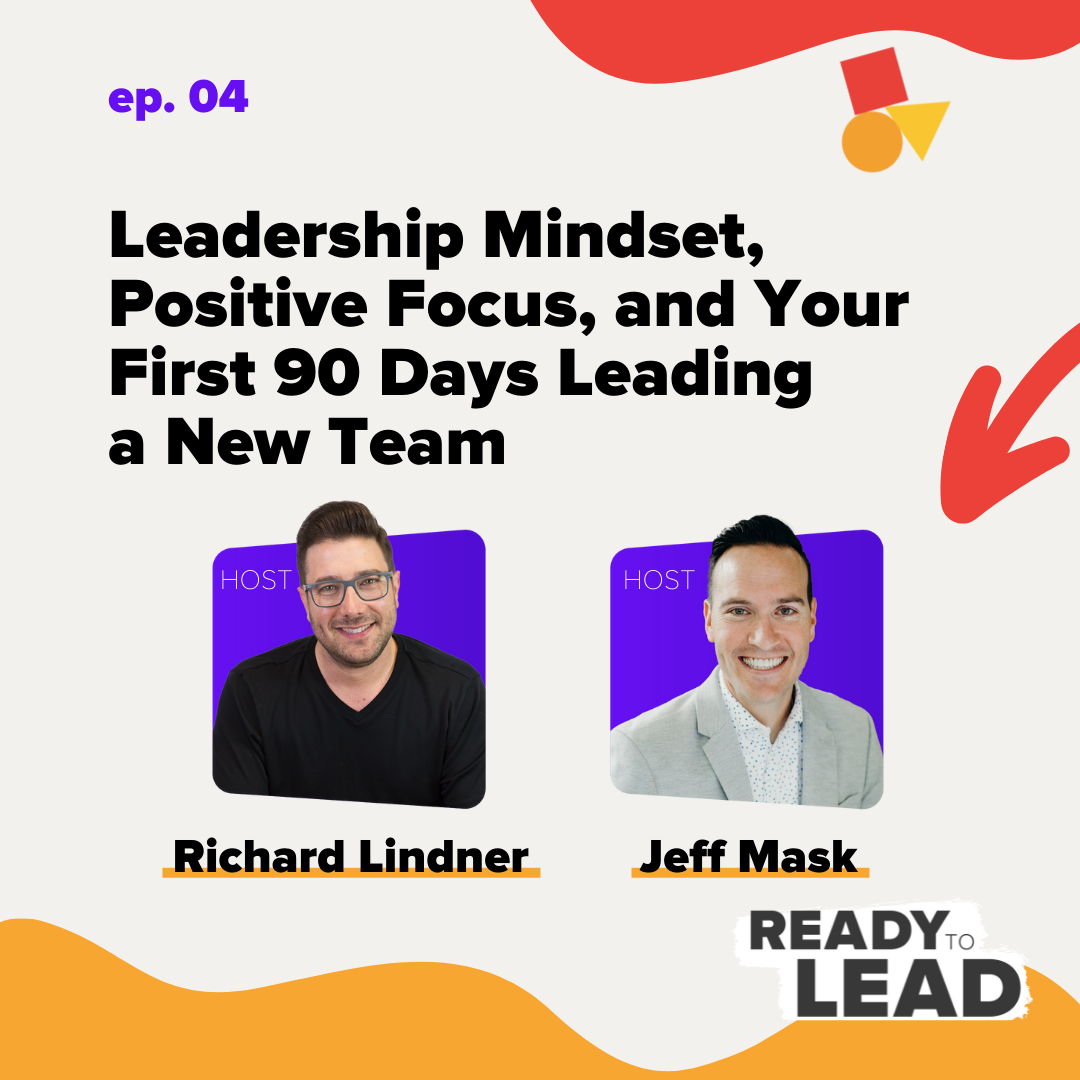The absolute foundation of leadership is a powerful positive mindset, and it needs to start on day one.
What comes to mind when you hear the word “mindset?” If you feel like mindset isn’t important, and you’re impatient to get to the tactics, the “good stuff,” then this episode is for you.
Co-hosts Richard Lindner and Jeff Mask reflect back on the days when they first started working together. Jeff introduced an exercise called “positive focus” and Richard wanted to skip it and move right to the solution to his problem. He quickly learned that, if you don’t start by fixing the problem of mindset, then every solution is a temporary band-aid.
In this episode, we’ll walk through mindset and positive focus, then move into some tactical suggestions for your first day, week, and months leading a new team.
Why Mindset and Positive Focus Are So Important
At the start of Richard’s first coaching session with Jeff, Jeff said, “Let’s start out with your positive focus.” Richard remembers thinking, “Better yet, why don’t you help me?” He really wanted to skip all the woowoo juju stuff and didn’t understand why Jeff was making him do it.
Richard said, “I don’t know, man. I got nothing.” And Jeff said, “Well, I guess we’re just going to sit here then. There’s something good, and we’re going to find it.”
Fast forward to today when they start off every weekly leadership meeting with positive focus, and Richard believes in it wholeheartedly. Jeff knows a lot of people can relate to Richard’s initial skepticism. Mindset can seem touchy-feely and unnecessary when there are difficult business problems to solve.
Jeff takes people back to the second Back to the Future movie when Doc Brown creates the time space continuum on the chalkboard and says “this is where we’ve been, and this is where we are.” He tells Marty that, when he went back in time, he changed something, and now there’s a new time space continuum, another 1985.
When we don’t start our meetings, our thoughts, from a place of positivity, we’re on a time space continuum that isn’t healthy because we’re thinking what we’re fearful and frustrated about. The highest part of our brain isn’t functioning. We’re in the bad 1985. When you reframe and refocus your brain on the positive, you start to exercise the higher-level functioning of your brain, the aspects that enable you to problem solve, learn, and create.
We’re wired as humans to be thinking more in the survival state, which is owned by the brain stem, the oldest part of our brain. When we try to solve problems from that part of our brain, we don’t get great outcomes.
Contrast that with the prefrontal lobes, the part that’s responsible for learning, adapting, creating, problem-solving, leadership. When we use that part of our brain, we hack ourselves to a higher level to get to a much deeper, better outcome. Jeff says at the beginning of every meeting, “Let’s hack our brains.”
A Simple Exercise to Realign Your Team’s Mindset
Leadership is not about protecting yourself. It’s about growing others, aligning others, and building a cohesive team. If you put yourself first, none of that works. If we understand the science behind it, understand the need for mindset, what is a simple exercise we can go through to realign our mindset?
Jeff recommends starting with a level one exercise. The question is simple: What are you grateful for in your life today? At the beginning of a meeting, you just go around the room and give everyone a chance to answer that question.
The level two question is this: What is something in your business that you’re excited about or grateful for? Encourage people to get super specific, add detail, paint a visual image. This starts to evoke emotion, which releases oxytocin and serotonin, good stuff in the brain that fuels you to solve big problems.
Give people time and space to think if they need it. If someone gives the copout, “I can’t think of anything,” say, “We’ll wait.”
Who starts? Jeff believes it’s powerful when the leader starts and shows some vulnerability first. And how long should it take? Five minutes is good—no more than 10% of the meeting time or people feel like they’re not getting traction. The only caveat is when the team needs healing for whatever reason, when you need to create a bond and trust.
How Do I Start Leading a Team?
How do we take a great mindset into leading a team? Maybe it’s your first time, or maybe you’ve led before but now you’re leading your peers. What do you do the first day, the first week, the first month?
Richard says, for him, the first day is all about introductions and information. He used to think it was all about power and authority, making sure everyone knew he was in charge and was there to fix all the problems. He suffered from arrogance, assuming there was no intelligence or great ideas before he got there.
Jeff taught him to make it about others, not himself, to ask, “What do people need to know, think, or feel?” The first day is 10% about Richard, 90% about this team. He has them fill out a team member profile with easy questions that give him insight into who they are. (Favorite snack? Restaurant? Hobby? Have a pet? A partner?)
Jeff likes to ask, “What do you like most about your job? What’s frustrating about your job?” He’ll say, “I’ll share just a little bit about myself, but I really want to get to know you.” He gets personal, so they see him as open and vulnerable—and a whole person. He tells them how long he’s been married, about his kids, that he loves to surf and accomplish crazy things.
He also shares some weaknesses, because he doesn’t want to give off the vibe that he’s perfect, because he’s not, and he likes that he’s not. He likes the joy of learning and growing and failing. Right from the get go, he sets the precedent that failing is fun, something everyone can learn/grow from.
Whatever your leadership style is, make sure you start communicating that right away. If you’re not a “my door’s always open” person, then make sure no one expects that.
The Value of a Keep-Start-Stop Exercise
By the end of that first week Richard likes to do a Keep-Start-Stop exercise where you ask everyone these three questions:
- What should we keep doing (or do even more of)?
- What should we start doing (that hasn’t been greenlit)?
- What should we stop doing (because it’s taking too much time or isn’t having the desired effect or is bad for the company, the customer, or the team)?
When you frame things like that, you’re telling people you hear them. After you get that information from them, your job is to attack it with curiosity, to figure out if it’s good for the company. Give them subtle lessons in presenting a business case. You think we should do more of this? Why? What stats are you using? How is it affecting overall company goals? What if you had more resources? Why do you think we should stop doing this? Why are we still doing it?
Get Into a Leadership Rhythm
In that first week, it’s important to start the rhythm of when will I be doing what? When will I meet weekly with my team one on one? When will I hold the weekly meeting? When will I review different dashboards and stats? Get into a cadence, because leadership can feel sporadic and urgent. If you’re not careful and don’t discipline how you’ll manage time, time will manage you. Be intentional about when you want to do what. Block out time for people, preparation, and proactive measures.
Human beings like consistency. We’re not talking about structuring every minute of every day, especially not for creative people. But even creative people like to have consistency so they know expectations and they’re prepared.
On that first day, seek to know. They know you; you know them. First week: make people feel heard. Understand what they’re thinking about in their role professionally and also set expectations for what the average day/week/month looks like.
Then the rest of the month is all about professional alignment. Sit down with each person and look at their job description. Does this accurately represent what you do? How are you measured? What are you responsible for? Get it all aligned, accurate, up-to-date. Get clarity.
The next episode is a mini-one where Jeff will answer the question: How do I make sure there’s clarity and everyone knows what winning looks like?
Richard and Jeff want to hear from YOU. Have feedback on the show? Topics you’d like them to dive into? Things that resonated with you or that you disagreed with? Email them here: feedback@readytolead.com
OTHER SHOWS YOU MIGHT ENJOY:
- Business Lunch with Roland Frasier and Ryan Deiss
- Perpetual Traffic with Ralph Burns and Kasim Aslam
- DigitalMarketer Podcast with Jenna Snavely


